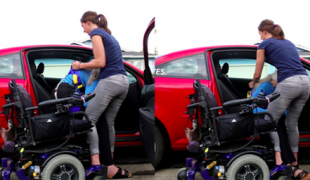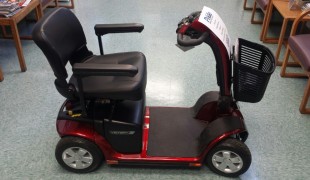- 7883
- 527
- 5
- 4
- 0
- Help Ukraine
About the solution
It consists of a shopping cart, made of PVC pipe, tick netting and wheels, that is lower to the ground and shallower than regular shopping carts, making it easier for people using wheelchairs to grocery shop, by having two levels. The heavier items are meant to be placed on top, which is adjustable. The cart has maneuverable handles so that a wheelchair-bound person can push it with minimal effort and awkwardness.
“A regular shopping cart is deeper than a person in a wheelchair can reach. You have a risk of falling”, the inventor explained.
Robert created this device because his grandfather didn’t want to be helped after his surgery.
“My grandfather had just had back surgery. He really didn’t want anyone to help him with anything. He hated it”, Robert stated.
The inventor started building this device while he was in high school, and then he went to study biomedical engineering, and he kept improving the product.
“There are millions of people who suffer from disabilities who are overwhelmed by every day activities. Even Meals on Wheels has to deliver to some of them because it’s so hard to shop for themselves. “Disabled people don’t want to rely on someone else,” he said. “They just need the tools to be able to rely on themselves”, the student affirmed.
Adapted from: http://bit.ly/2jZ3EZg
This solution shall not include mention to the use of drugs, chemicals or biologicals (including food); invasive devices; offensive, commercial or inherently dangerous content. This solution was not medically validated. Proceed with caution! If you have any doubts, please consult with a health professional.
DISCLAIMER: This story was written by someone who is not the author of the solution, therefore please be advised that, although it was written with the utmost respect for the innovation and the innovator, there can be some incorrect statements. If you find any errors please contact the patient Innovation team via info@patient-innovation.com
-
-
378
-
0
-
6459

Harness to help transfer disabled and elderly people from wheelchair to the car
STANDING UP: Standing up from a seated position
WALKING WITH A WALKING AID: Walking with a walking aid
CAREGIVING
Mobility impairments
Assistive Daily Life Device (to help ADL)
Walking Aid (wheelchair/walker/crutches)
Promoting self-management
Maintaining Balance and Mobility
Caregiving Support
Neurology
Physical Medicine and Rehabilitation
United States
-
-
-
640
-
0
-
8865

Drive-Master - adaptive mobility equipment
MOVING IN A WHEELCHAIR: Moving using a wheelchair.
WALKING WITH A WALKING AID: Walking with a walking aid
CAREGIVING
Polio
Assistive Daily Life Device (to help ADL)
Walking Aid (wheelchair/walker/crutches)
Muscle cramps or spasms
Difficulty coordinating movements
Stiffness or rigidity (difficulty moving)
Paralysis of the legs and lower body
Muscle weakness
Restoring mobility
Promoting self-management
Managing Neurological Disorders
Promoting inclusivity and social integration
Caregiving Support
Neurology
Physical Medicine and Rehabilitation
Rheumatology
United States
-
-
-
569
-
0
-
7732

Man creates smartphone keyboard case to help his mother
COMMUNICATION: Communicating, whether by speaking, listening, or other means
CAREGIVING
Social interaction
Brain Stroke
Assistive Daily Life Device (to help ADL)
Assistive Technology access
Promoting self-management
Raise awareness
Caregiving Support
General and Family Medicine
Internal Medicine
Neurology
Occupational Medicine
Physical Medicine and Rehabilitation
Vascular Surgery
Norway
-
 en
en